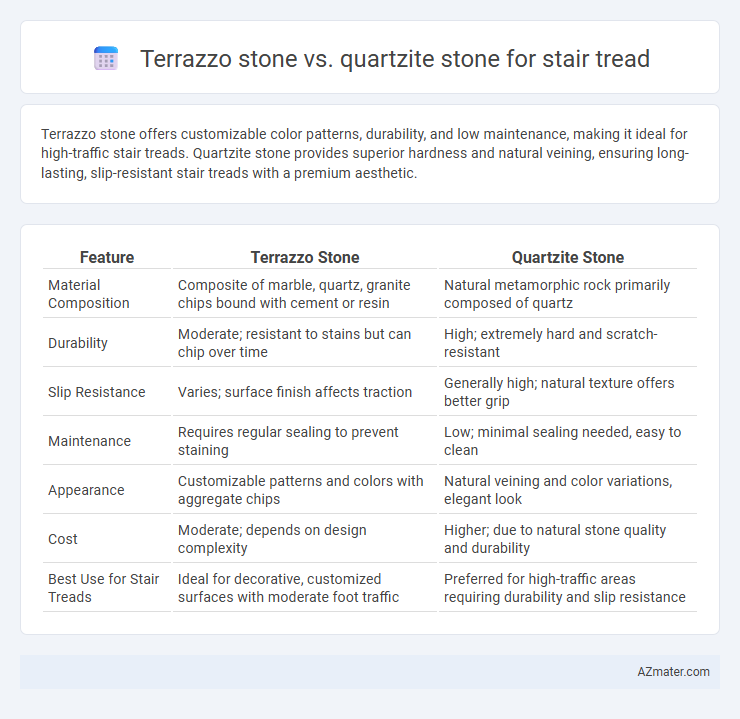Terrazzo stone offers customizable color patterns, durability, and low maintenance, making it ideal for high-traffic stair treads. Quartzite stone provides superior hardness and natural veining, ensuring long-lasting, slip-resistant stair treads with a premium aesthetic.
Table of Comparison
| Feature | Terrazzo Stone | Quartzite Stone |
|---|---|---|
| Material Composition | Composite of marble, quartz, granite chips bound with cement or resin | Natural metamorphic rock primarily composed of quartz |
| Durability | Moderate; resistant to stains but can chip over time | High; extremely hard and scratch-resistant |
| Slip Resistance | Varies; surface finish affects traction | Generally high; natural texture offers better grip |
| Maintenance | Requires regular sealing to prevent staining | Low; minimal sealing needed, easy to clean |
| Appearance | Customizable patterns and colors with aggregate chips | Natural veining and color variations, elegant look |
| Cost | Moderate; depends on design complexity | Higher; due to natural stone quality and durability |
| Best Use for Stair Treads | Ideal for decorative, customized surfaces with moderate foot traffic | Preferred for high-traffic areas requiring durability and slip resistance |
Introduction to Terrazzo and Quartzite Stair Treads
Terrazzo stair treads are composed of chips of marble, quartz, granite, or glass set in cement or epoxy resin, offering a highly durable and customizable surface with unique, colorful patterns. Quartzite stair treads, made from a natural metamorphic rock, provide exceptional hardness, resistance to abrasion, and a natural stone aesthetic with subtle veining and a smooth finish. Both materials are popular choices for stair treads due to their strength, slip resistance, and ability to withstand heavy foot traffic in residential and commercial settings.
Material Composition of Terrazzo vs Quartzite
Terrazzo stone consists of a composite material made from marble, quartz, granite chips embedded in a cement or epoxy binder, providing high versatility and design customization. Quartzite stone is a natural metamorphic rock primarily composed of silicon dioxide, known for its exceptional hardness and resistance to abrasion. The cement-based matrix in terrazzo offers more flexibility in color and pattern compared to the uniformly crystalline structure of quartzite, which delivers superior durability and natural texture for stair tread applications.
Aesthetic Appeal and Design Options
Terrazzo stone offers a highly customizable aesthetic with vibrant color chips embedded in a polished matrix, providing unique patterns and a contemporary look ideal for modern stair treads. Quartzite stone features natural veining and a variety of earthy tones, delivering a sophisticated and timeless appearance that enhances traditional or transitional stair designs. Both materials provide durable options, but terrazzo's design flexibility surpasses quartzite's natural stone variations, allowing for more personalized stair tread aesthetics.
Durability and Longevity Comparison
Terrazzo stone offers exceptional durability due to its composite material of marble chips and cement or resin, resistant to heavy foot traffic and impacts on stair treads. Quartzite stone, a natural metamorphic rock, excels in hardness and scratch resistance, ensuring long-lasting stair tread performance with minimal wear over time. Both materials provide superior longevity, but quartzite generally outperforms terrazzo in resisting abrasion and maintaining structural integrity under constant use.
Maintenance Requirements for Each Material
Terrazzo stone for stair treads requires regular sealing and periodic polishing to maintain its smooth, glossy surface and prevent staining, while quartzite stone demands less frequent sealing due to its natural hardness and resistance to scratches. Both materials benefit from routine cleaning with pH-neutral cleaners, but terrazzo's porous composition makes it more susceptible to etching and discoloration from harsh chemicals. Quartzite's dense, durable structure ensures lower maintenance efforts over time, making it ideal for high-traffic stairways requiring long-lasting resilience.
Slip Resistance and Stair Safety
Terrazzo stone offers superior slip resistance for stair treads due to its textured surface and embedded aggregate, enhancing stair safety in both residential and commercial settings. Quartzite stone, although extremely durable and visually appealing, tends to have a smoother finish that may require additional anti-slip treatments to prevent slipping hazards. Prioritizing slip resistance, Terrazzo stone is often the preferred choice for stair applications that demand high safety standards and reduced accident risk.
Cost Analysis: Terrazzo vs Quartzite
Terrazzo offers a cost-effective option for stair treads, with prices typically ranging from $20 to $80 per square foot, making it more budget-friendly than quartzite. Quartzite, known for its durability and natural stone appearance, usually costs between $40 and $100 per square foot, reflecting higher material and installation expenses. Choosing Terrazzo can reduce upfront costs while still delivering a stylish finish, whereas quartzite demands a larger investment for premium aesthetics and long-term resilience.
Environmental Impact and Sustainability
Terrazzo stone is highly sustainable due to its use of recycled materials such as glass, marble chips, and cement, reducing waste and lowering the carbon footprint during production. Quartzite stone, a natural metamorphic rock, offers durability and longevity which minimizes the need for frequent replacements, but its quarrying process can cause significant environmental disruption and higher energy consumption. Choosing terrazzo for stair treads supports eco-friendly practices through material reuse, while quartzite provides a natural, long-lasting option with a greater initial environmental impact.
Ideal Applications for Each Stone Type
Terrazzo stone is ideal for stair treads in commercial and high-traffic areas due to its durability, customizable patterns, and resistance to wear and stains. Quartzite stone offers superior hardness and natural slip resistance, making it perfect for outdoor stair treads or spaces requiring a natural stone appearance with long-lasting strength. Choosing between terrazzo and quartzite depends on specific site needs, aesthetic preferences, and maintenance considerations for optimal performance.
Conclusion: Choosing the Right Stone for Stair Treads
Terrazzo stone offers a durable, low-maintenance surface with customizable aesthetics perfect for high-traffic stair treads, while quartzite provides superior natural hardness and resistance to scratching and heat. For stair treads requiring both elegance and extreme durability, quartzite is ideal due to its natural stone composition and long-lasting strength. Selecting Terrazzo or quartzite depends on balancing budget, design preference, and the desired performance characteristics in stair tread applications.

Infographic: Terrazzo stone vs Quartzite stone for Stair Tread
 azmater.com
azmater.com